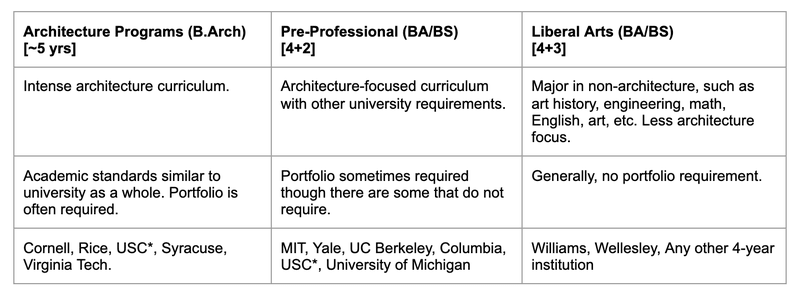
In this article, CollegeAdvisor.com admissions expert and Phillip Hu (MIT ‘15) provides an overview for applying to college architecture programs. For more guidance on specialized college programs and the college application process in general, sign up for a monthly plan to work with an admissions coach 1-on-1.
Architects are responsible for designing the built environment, from chairs to skyscrapers. Architects combine creativity, logic, and collaboration to solve problems and design buildings.
The most rewarding aspect of practicing architecture is seeing your efforts materialized in the real world. The first time I walked around in a dusty construction site of a project I helped design felt incredibly powerful! But the process of design itself is also exhilarating.
The first step of being an architect is attending an architecture program in college. This guide will help you figure out what path best fits your needs.
The first half of this article covers the following information:
- The Path to Becoming an Architect
- Choosing the Right Program
For strategies and tips for your application, see my accompanying blog post here.
The Path to Becoming an Architect
Similar to engineers, architects require an architectural license to practice. Though each jurisdiction has its own licensure process, the process generally in the US is:
- Earn an architecture degree from an NAAB-accredited program, typically either a B.Arch or M.Arch.
- Gain and document required experience through internships and early architectural design positions.
- Pass the Architectural Registration Examination (ARE)
A license essentially allows you to officially declare yourself an “Architect” who can sign off on building plans and declare them ready for construction. While a license is not required to work in an architecture firm, it can help you advance your career and gain bigger responsibilities at the firm. From my experience, designers will pursue a license around mid-career, about 5 – 10 years after graduating. Regardless, a professional architecture degree and design portfolio will be required to jumpstart your architecture career.
Choosing the right college architecture program
When thinking of your school list, one of the most important questions to ask is, “How committed am I to architecture?” Even if your answer is 110%, still consider these other options.
Undergraduate architecture education falls roughly into three categories:
- Architecture-intensive B.Arch
- Pre-Professional Architecture
- Related Major/Liberal Arts.
In all paths, expect to dedicate a lot of time to your design studio course. Most of your college life will be defined by studio. There’s a reason other students joke that they never see architecture students, but your studio will become your second family!
The B.Arch is the only option where you do not need a Master’s in Architecture (M.Arch) to eventually practice architecture. For any other undergraduate degree, you will need to complete a two- to three-year M.Arch program.

*USC offers both a B.Arch and BS option.
Bachelor of Architecture (B.Arch)
This is a great option:
- If you’re 110% committed to architecture.
- If you want a degree that will allow you to be a licensed architect after graduating without a Master’s (M.Arch). Many students eventually pursue a M.Arch even after attending a B.Arch program, but they often can apply with some kind of advanced standing.
What you should expect from the program:
- Studio-intensive
- Five to six years
- Less academic flexibility, since most of your time will be spent fulfilling degree requirements
- Often ends with a thesis or capstone project
Some great B.Arch schools to consider:
- Cornell
- Rice
- RISD
- Syracuse
- Virginia Tech
- Cal Poly, San Luis Obispo
Your goal at the end of a B.Arch is to graduate with a job-ready portfolio (or graduate school-ready portfolio) and numerous internship experiences.
Pre-Professional Program
This is generally a Bachelor of Science in Architecture or something similar. This is a great option:
- If you want to focus on architecture but know that you want to pursue a two-year M.Arch (sometimes three).
- If you’re still a bit on the fence but very passionate about architecture, or don’t have a strong arts portfolio.
- Or, if you have multiple interests (like computer science or French literature) you might want to also explore.
What you should expect from the program:
- Studio-intensive
- Four years
- Some academic flexibility to explore other interests or specializations
Some great pre-professional programs to consider:
- MIT
- University of Michigan
- UC Berkeley
A strong pre-professional program often accompanies a strong M.Arch program since you will likely have access to the same resources. Your goal for the end of your four years is to develop a personal design voice through your portfolio and supporting courses in preparation for a M.Arch application. But a strong M.Arch portfolio can draw from a variety of interests, whether it’s in building technology, painting, or digital media.
Related Major or Liberal Arts
This is a great option:
- If you are still unsure about architecture or recently discovered it
- If you want a flexible liberal arts college (LAC) experience
If you do go this route, you will still need a fantastic portfolio for competitive M.Arch programs, so you should try to take as many architecture and visual art studio courses as possible. Consider LACs with strong visual arts departments and opportunities. At some LAC’s, you can also major in architectural studies. But take advantage of the academic flexibility and choose courses that genuinely interest you— whether it’s math, political science, theater, or biology. The intersection of interests will help you create a unique voice for your future M.Arch application.
If you feel your school is lacking in architectural courses or your portfolio needs a boost, consider applying to Harvard’s Design Discovery Program. But these programs can be pretty expensive ($3,900 tuition + housing and food costs for the 6-weeks).
How versatile is a degree from a college architecture program?
Lots of people think declaring your major in architecture is a life-long commitment. But an architecture background isn’t as specialized as one might think. You can apply your design foundation to a lot of jobs. I ended up pursuing urban planning because I was more interested in the systems between buildings that connect us. One of my architecture friends from MIT is now a project manager for a rapidly growing B2B tech firm. Another friend is a head bartender of a hip Izakaya-style bar in NYC. All of us still apply a rigorous design process to our work, whether it’s designing cities, managing projects, or concocting new cocktails.
So don’t be afraid to declare architecture as your major! As you go through school and meet interesting classmates, professors, and alumni, you’ll see that many people don’t follow a linear trajectory. You’ll eventually figure out a path that makes sense to you, as long as you stay curious and keep an open mind.
Final Thoughts
Now that you know what your options are, you should be ready to start creating a school list that best fits your goals. Read on to Part II to learn how you can improve your architecture school application through the right coursework, extracurriculars, and essays!
This informational essay on college architecture programs was written by Phillip Hu, MIT ’15. If you want to get help with your college applications from Phillip or other CollegeAdvisor.com Admissions Experts, register with CollegeAdvisor.com today.
